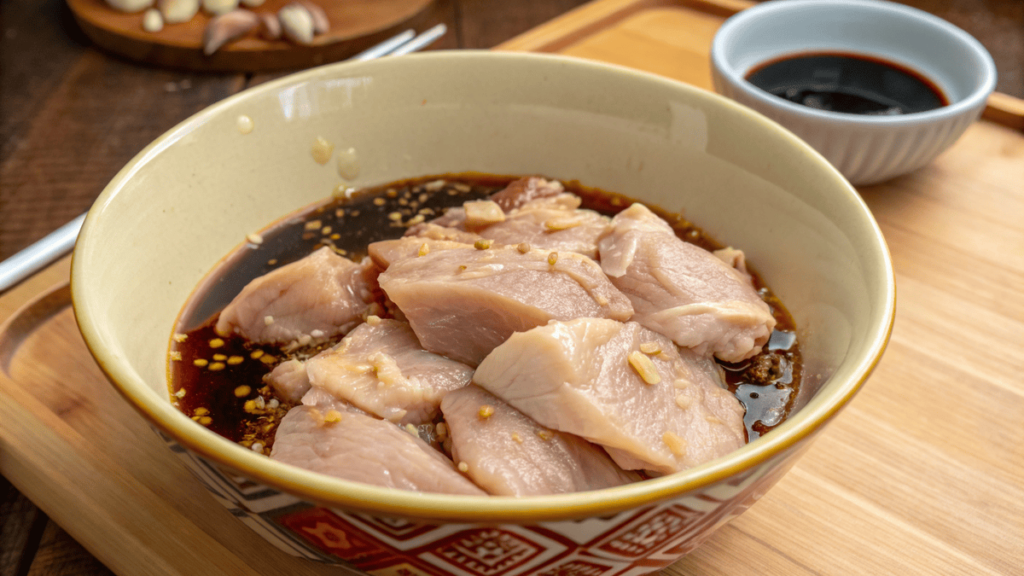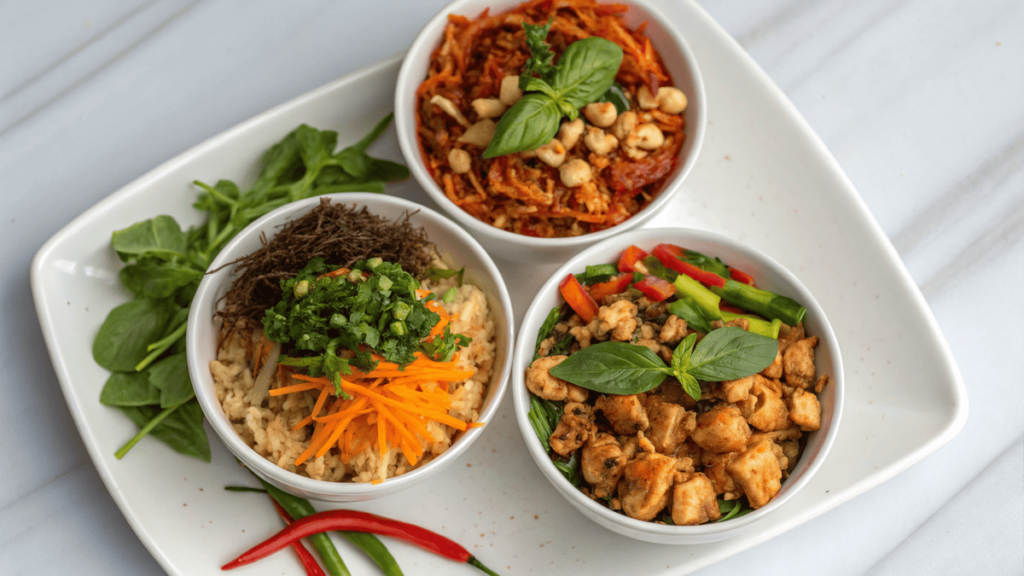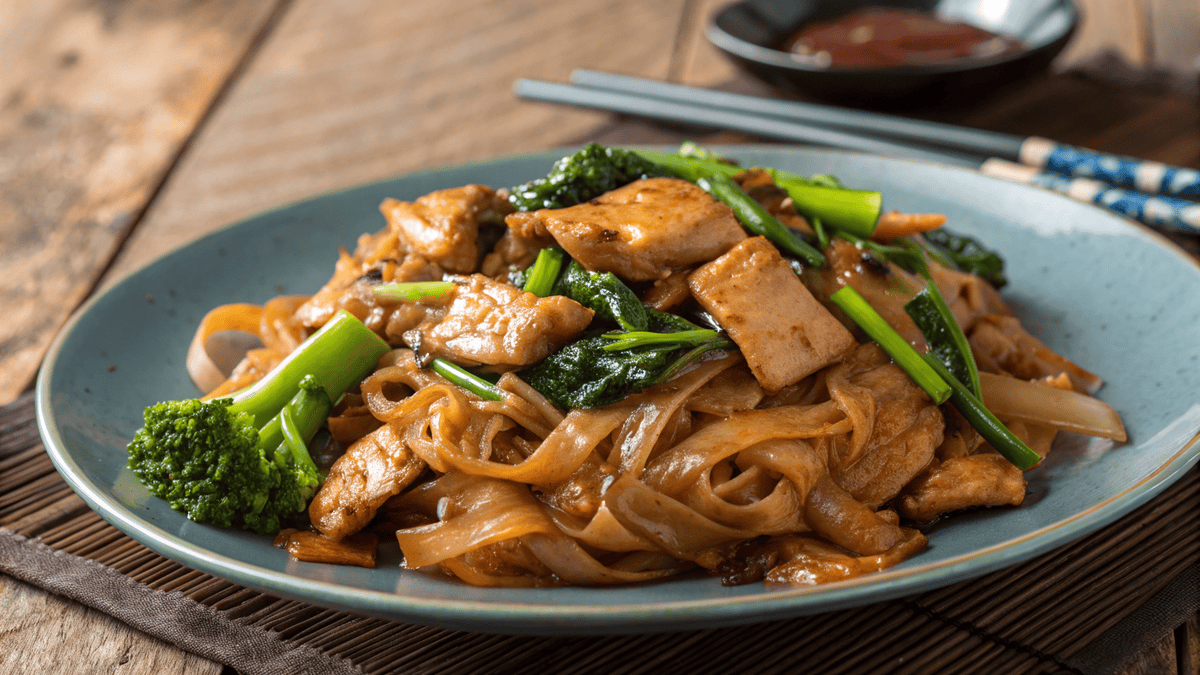Love takeout but wish it were a little healthier, a lot fresher, and packed with even more flavor? You’re not alone. That’s why we’re diving into the delicious world of Phat si io recipe chicken—a savory, soy-slicked stir-fried noodle dish that rivals (and maybe beats) your favorite Thai restaurant’s version.
In this article, you’ll get everything you need to make this Thai classic from the comfort of your own kitchen. From a breakdown of ingredients and smart substitutions to step-by-step cooking instructions, flavor hacks, and storage tips, we’ve got you covered. We’ll even take a quick trip into the dish’s cultural roots and answer the most common questions people ask about it.
Let’s get cooking!
Table of Contents
Introduction to Phat Si Io Chicken
What is Phat Si Io?
So, what exactly is Phat si io (or Pad See Ew, depending on the transliteration)? Well, imagine wide, chewy rice noodles stir-fried with soy sauce until they’re kissed by fire, then tossed with juicy bites of chicken and crisp Chinese broccoli. The name literally means “fried with soy sauce,” and that’s exactly what makes this dish pop—a rich blend of dark and light soy sauces that caramelize beautifully on the noodles.
Originating from Thailand but heavily influenced by Chinese cooking, this dish is a cornerstone of Thai street food. It’s hearty, comforting, and hits all the right savory notes with just a touch of sweetness.
Unlike Pad Thai, which leans tangy and nutty, Phat Si Io is all about that deep umami flavor—think stir-fried chicken noodles with a smoky, slightly charred edge.
Why Choose Chicken in Phat Si Io?
While the dish is often made with pork or beef, opting for chicken is a game-changer. First off, it’s leaner and easier to cook quickly—especially if you use boneless chicken thighs. Plus, chicken soaks up those bold flavors like a sponge, making every bite incredibly juicy and satisfying.
Chicken also makes this a go-to option for weeknight dinners. It’s faster, more affordable, and widely loved—even picky eaters dig in with gusto. So if you’re searching for a Phat si io recipe chicken version that’s healthy and mouthwatering, you’re in the right place.
Ingredients Breakdown & Substitutions
Essential Ingredients for Chicken Phat Si Io

To whip up an unforgettable Phat si io recipe chicken dish, you’ll need a handful of simple but powerful ingredients. Let’s start with the stars of the show—wide rice noodles and chicken.
Go for fresh sen yai (wide rice noodles) if you can find them. They’re chewy, slightly sticky, and ideal for absorbing rich sauces. If not, dried wide rice noodles are a solid backup—just soak them until they’re soft but not mushy.
Next comes the protein. Boneless, skinless chicken thighs work best because they stay juicy and flavorful under high heat. Chicken breast is also fine, but make sure you don’t overcook it.
Now for the flavor bombs:
- Dark soy sauce – adds that signature deep color and a slightly sweet richness.
- Light soy sauce – balances things with salty umami.
- Oyster sauce – thick and savory, this ties everything together.
- Garlic – because what’s stir-fry without garlic?
- Sugar – just a pinch to round out the saltiness.
- Chinese broccoli (gai lan) – offers a slightly bitter, crunchy contrast.
And don’t forget the oil—go with something that can handle heat, like peanut or vegetable oil.
Substitution Guide
No wide noodles at your local store? No problem. You can use tagliatelle rice noodles or even fresh lasagna sheets cut into strips. It’s not traditional, but it gets the job done.
Can’t find Chinese broccoli? Broccolini or kale will do the trick. And if oyster sauce isn’t your thing, try mushroom stir-fry sauce for a vegetarian twist.
Remember, Phat si io recipe chicken is forgiving. As long as you nail the sauces and cook with high heat, it’ll taste like pure comfort.
Choosing the Right Chicken for Phat Si Io
Best Cuts for Stir-Fry
Let’s talk chicken. The secret to a great Phat si io recipe chicken is choosing the right cut. While breast meat is often used, boneless chicken thighs are where the magic happens. They’re juicier, more flavorful, and less likely to dry out during the quick stir-fry process.
Still prefer chicken breast? No worries! Just slice it thin and marinate it for 10–15 minutes in soy sauce, oyster sauce, and a splash of oil. This helps lock in moisture and infuse flavor fast.

Marination Tips for Enhanced Flavor
Even a quick marinade goes a long way. In fact, mixing the chicken with a little garlic, light soy sauce, and oyster sauce before cooking helps it develop that signature umami depth.
For extra punch, toss in a dash of white pepper or a spoonful of hoisin sauce. Let it sit for at least 10 minutes while you prep the rest. Trust us—it’s worth the wait.
This step isn’t just about flavor, either. Marinated chicken cooks better, caramelizes faster, and clings beautifully to the noodles. And if you’re aiming for that better-than-takeout vibe? This is the move.
Cooking Method for Perfect Phat Si Io Chicken
Step-by-Step Cooking Process
Alright, let’s roll up those sleeves! The magic behind a killer Phat si io recipe chicken lies in the cooking process. Unlike slow-cooked dishes, this one is all about fast, high-heat action. So get everything ready—mise en place is your best friend here.
- Prep the chicken and noodles
Slice your marinated chicken into bite-sized pieces. If using dried rice noodles, soak them until soft, then drain. If using fresh noodles, gently separate them. - Heat your wok
Crank up the heat. You want it smoking hot—literally. Add a couple of tablespoons of oil and swirl to coat. - Cook the chicken first
Add the chicken and spread it out. Let it sear without moving it for about 30 seconds, then stir-fry until golden and cooked through. Remove and set aside. - Toss in garlic and veggies
Add chopped garlic, stir for a few seconds, then toss in the Chinese broccoli stems. Stir-fry until tender-crisp, then add the leafy parts. - Noodle time
Throw in the noodles and give them a minute to char slightly before stirring. Pour in your sauce mix—dark soy, light soy, oyster sauce, and a touch of sugar. - Bring it all together
Return the chicken to the pan. Toss everything together until the noodles are evenly coated and slightly caramelized.
For a lightning-fast noodle dish with a garlicky twist, you might also enjoy our Quick Garlic Noodles Recipe.
Common Mistakes and How to Avoid Them
Even a great Phat si io recipe chicken can flop if you’re not careful. Here’s what to watch out for:
- Using too much sauce – Noodles should be coated, not drowning.
- Overcrowding the wok – Stir-frying needs space. If necessary, cook in batches.
- Low heat – If your wok isn’t hot enough, you’ll end up with soggy noodles, not that crave-worthy sear.
Stick to high heat, keep the ingredients moving, and don’t be afraid to let some bits get a little charred—it’s part of the flavor!
Better Than Takeout – Why Homemade Wins
Flavor Customization at Home
Let’s be honest—takeout is convenient, but homemade Phat si io recipe chicken? Game-changer. You get to tweak the flavors to fit your style. Want it saltier? Add more light soy. Prefer that smoky edge? Let those noodles sit a second longer in the pan.
You can also control the spice. Add chili flakes, Sriracha, or even some Thai bird’s eye chilis for a fiery kick. No surprise oils, no hidden sugar bombs—just bold, balanced flavor tailored to your cravings.
Healthier and Fresher
Here’s the kicker: your version isn’t just tastier—it’s healthier. You get to pick the quality of meat, go light on the oil, and pile on the veggies. That’s a win for your taste buds and your body.
Plus, everything’s fresh. No reheated noodles or day-old meat. Just vibrant greens, juicy chicken, and sizzling garlic straight from your wok to your plate.
And guess what? Cleanup’s a breeze with one pan and minimal prep. So next time you’re tempted to hit “order now,” remember—you’ve got the better option in your own kitchen.
Variations of Phat Si Io Chicken

Spicy Phat Si Io with Chicken
Craving heat? Great news—Phat si io recipe chicken is super easy to turn up a notch. If you’re a spice lover, toss in some sliced Thai bird’s eye chilis while stir-frying the garlic. These tiny peppers pack a fiery punch and instantly elevate your dish.
Prefer a slow burn? Mix in a spoonful of chili paste, like sambal oelek, into your sauce blend. Or go bold with a drizzle of Sriracha on top before serving. Either way, spicy Phat si io brings a new dimension that’ll have your taste buds doing a happy dance.
Even better, spice levels are easy to adjust. Add a little, taste, then add more. This is your kitchen—your heat, your rules.
Vegetable-Heavy Versions
Trying to squeeze more veggies into your meals? No problem. This dish adapts beautifully. While Chinese broccoli is classic, don’t stop there. Try tossing in julienned carrots, baby corn, snap peas, or red bell peppers for a rainbow of texture and flavor.
The trick is to cook hard veggies a bit longer and add delicate ones (like spinach or bean sprouts) at the end. That way, everything stays crisp and colorful.
By boosting the veggie content, you’re making your Phat si io recipe chicken more balanced—and honestly, even more satisfying. Plus, it’s a great way to clear out your fridge and avoid waste.
Serving & Pairing Ideas
What to Serve with Phat Si Io Chicken
While Phat si io recipe chicken is a full meal on its own, it also plays well with others. Want a refreshing side? Try a crisp Thai cucumber salad—the tangy dressing and cool crunch contrast beautifully with the rich noodles.
You can also serve it with a simple clear vegetable soup or even a spicy tom yum for a flavor-packed combo. And of course, don’t forget the classics: a wedge of lime, some crushed peanuts, and maybe a sprinkle of fried garlic on top for that extra oomph.
Presentation Tips for Hosting
Serving this dish at a dinner party? Make it pop by plating it in a large shallow bowl with chopsticks or a colorful Thai-style spoon on the side. Garnish with lime wedges, fresh herbs like cilantro or Thai basil, and a sprinkle of sesame seeds.
Trust us—your Phat si io recipe chicken will look as good as it tastes!
Make-Ahead and Storage Tips
Meal Prep Friendly Chicken Phat Si Io
If you’re big on batch cooking, you’re going to love this—Phat si io recipe chicken is super meal-prep friendly. You can cook it in advance, portion it out, and enjoy a flavorful meal anytime. It holds up well in the fridge for up to 3 days, and the flavors actually deepen overnight.
To meal prep like a pro, store the noodles and chicken separately from any garnishes or fresh herbs. This helps keep everything tasting fresh when you reheat it.
How to Reheat Without Overcooking
Now, here’s the trick to reheating: skip the microwave. Instead, heat a non-stick pan or wok over medium-high heat. Add a splash of water or oil, then toss the noodles in until warmed through. This method keeps your Phat si io recipe chicken juicy and the noodles springy—not soggy.
Need a fast lunch or dinner on a busy day? Reheat, plate, and enjoy. Easy as that.
Phat Si Io Chicken – Cultural Context
Thai Street Food Origins
Let’s zoom out for a moment. While Phat si io recipe chicken is now a home kitchen favorite, it was born on the bustling streets of Thailand. Vendors whip it up on blazing-hot woks right in front of you, often in under five minutes. That smoky, slightly charred flavor? It’s called wok hei, and it’s what gives the dish its irresistible edge.
This isn’t just fast food—it’s soul food. The kind that fuels late-night cravings, lunch breaks, and family gatherings across Southeast Asia.
Influence of Chinese-Thai Cuisine
Interestingly, this dish also shows the deep Chinese roots woven into Thai cuisine. From the use of soy sauce to the stir-fry method itself, Phat si io is a perfect blend of cultures. It’s where Chinese technique meets Thai flavors.
So every time you make a Phat si io recipe chicken, you’re not just cooking—you’re tasting a little piece of culinary history.
For more details about this recipe, check out Pad see ew.
FAQs
Q: What noodles do they use in Pad See Ew?
Pad See Ew—also known as Phat si io—traditionally uses wide rice noodles, often called sen yai in Thai. These fresh noodles are flat, chewy, and perfect for soaking up the rich soy-based sauce. If you can’t find fresh ones, dried wide rice noodles work too. Just make sure to soak or boil them until they’re soft but not mushy before stir-frying.
Q: What vegetables are in chicken Pad Thai?
While Pad Thai differs from Phat si io recipe chicken, it still brings a vibrant veggie mix. Common vegetables in chicken Pad Thai include:
Bean sprouts
Scallions (green onions)
Shredded carrots
Sometimes red cabbage or bell peppers
It’s all about color, crunch, and freshness. The veggies balance the sweet, tangy, and nutty flavors of the dish perfectly.
Q: Is Pad See Ew the same as Drunken Noodles?
Not quite. While they’re both Thai stir-fried noodle dishes and may look similar, they have distinct personalities. Pad See Ew (Phat si io) is milder, using soy sauce as its base and focusing on a sweet-savory flavor with Chinese broccoli and sometimes egg.
Drunken Noodles (Pad Kee Mao) bring the heat—with spicy chili, Thai basil, and garlic leading the way. It’s bold, fiery, and more aromatic thanks to the herbs and spice.
So, same family, different vibes.
Q: Which is healthier, Pad Thai or Drunken Noodles?
It depends on how they’re made. Pad Thai often includes peanuts, sugar, and sometimes tamarind paste, making it a bit richer and slightly higher in calories. Drunken noodles, on the other hand, tend to be lighter on sugar but heavier on oil and spice.
Both can be healthy with the right tweaks—like using lean protein, adding more veggies, and moderating sauce amounts. But if you’re going low on sugar, drunken noodles might edge out Pad Thai—just watch the oil!
Conclusion
And there you have it—the ultimate guide to making Phat si io recipe chicken right in your own kitchen. From picking the perfect cut of chicken to mastering that smoky stir-fry technique, you’re now fully equipped to whip up a dish that’s not just better than takeout—it’s next-level delicious.
Whether you stick to the classic version or spice it up with your favorite veggies and sauces, this recipe is flexible, fast, and full of flavor. Plus, it’s easy to meal prep, healthier than most restaurant versions, and an absolute crowd-pleaser.
So the next time that craving hits, skip the delivery app and fire up your wok. Your homemade Phat si io recipe chicken will blow the competition out of the water—and your kitchen will smell amazing while you’re at it.
Happy cooking, and don’t forget to share this flavorful favorite with your fellow noodle lovers!

